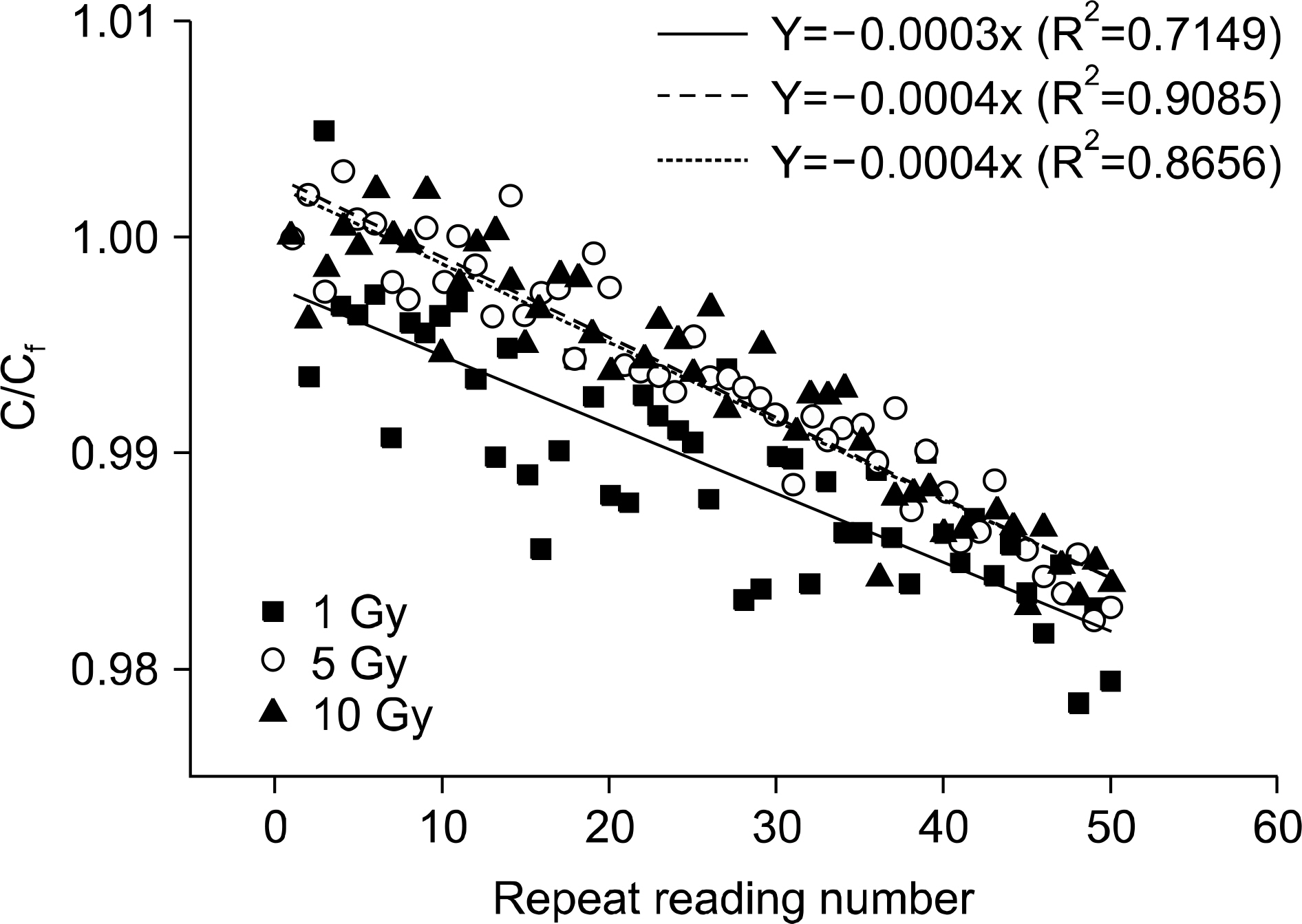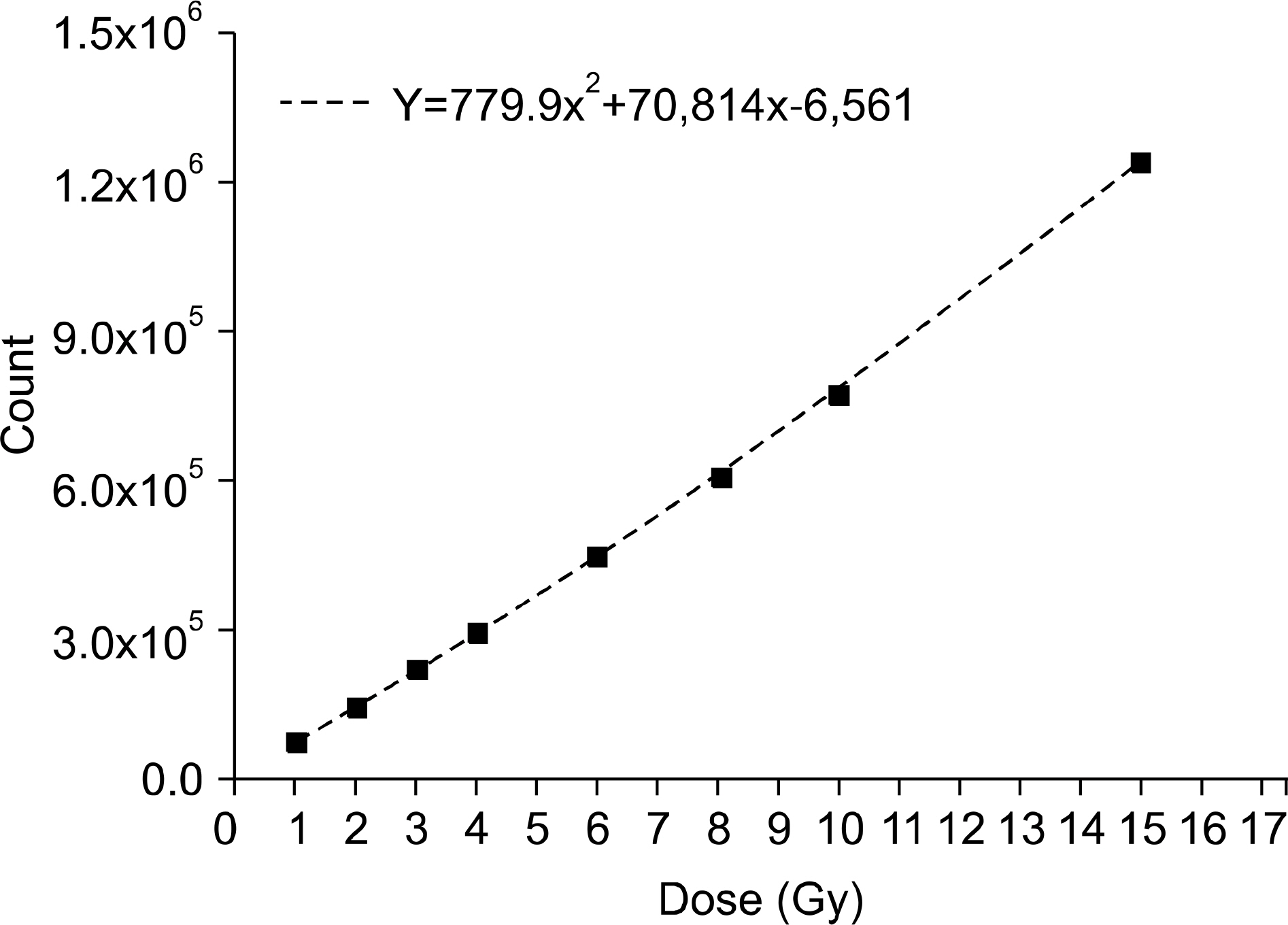Prog Med Phys.
2014 Mar;25(1):31-36. 10.14316/pmp.2014.25.1.31.
Evaluation of Dosimetric Characteristics of Reproducibility, Linearity and Dose Dependence of Optically Stimulated Luminescence Dosimeters in Co-60 Gamma-rays
- Affiliations
-
- 1Radiological Cancer Medicine, University of Science and Technology, Daejeon, Korea. kbkim@kirams.re.kr
- 2Research Center for Radiotherapy, Korea Institute of Radiological and Medical Sciences, Seoul, Korea.
- 3Department of Radiation Oncology, Korea Institute of Radiological and Medical Sciences, Seoul, Korea.
- 4Division of Methodology for Quality of Life, Korea Research Institute of Standards and Sciences, Daejeon, Korea.
- 5Department of Nuclear Engineering, Hanyang University, Seoul, Korea.
- KMID: 1910556
- DOI: http://doi.org/10.14316/pmp.2014.25.1.31
Abstract
- We aimed to evaluate the dosimetric characteristics of reproducibility, linearity and dose dependence of optical stimulated luminance dosimeter (OSLD) in the Co-60 Gamma-rays and to analyze with a precedent study in field of the diagnostic radiography and radiotherapy. The reproducibility was 0.76% of the coefficient of variation, the homogeneity was within 1.5% of the coefficient of variation and OSLD had supra-linear response more than 3 Gy. So the correlation between dose and count was fitted by quadratic function. The count depletion by repeated reading was 0.04% per reading regardless of the irradiated dose. And the half time of decay curve according to the irradiated dose was 0.68 min. with 1 Gy, 1.04 min. with 5 Gy, and 1.10 min. with 10 Gy, respectively. In case of annealing for 30 min, the removal rate was 88% with 1 Gy, 90% with 5 Gy, and 92% with 10 Gy, respectively and 99% in case of annealing time for 4 hour. It is feasible to use OSLDs for dose evaluation in Co-60 Gamma-rays when considering the uncertainty on the procedure according to the irradiated dose.
Figure
Reference
-
1. Aguirre J, Alvarez P, Amador C, Tailor A, Followill D. WE-D-BRB-08: Validation of the commissioning of the optically stimulated luminescence (OSL) system for remote dosimetry audits. Med Phys. 37(6):3428. 2010.2. Yu C, Luxton G. TLD dose measurement: a simplified accurate technique for the dose range from 0.5 cGy to 1000 cGy. Med Phys. 26(6):1010–1016. 1999.
Article3. Jursinic PA. Characterization of optically stimulated luminescent dosimeters, OSLDs for clinical dosimetric measurements. Med Phys. 34(12):4594–4604. 2007.
Article4. Viamonte A, da Rosa LA, Buckley LA, A Cherpak A, Cygler JE. Radiotherapy dosimetry using a commercial OSL system. Med Phys. 35(4):1261–1266. 2008.
Article5. Al-Senan RM, Hatab MR. Characteristics of an OSLD in the diagnostics energy range. Med Phys. 38(7):4396–4405. 2011.6. Han S, Kim K, Park S, Lee S, Yi C, Kim H, Jung H, Kim M, Ji Y. SU-E-T-31: The evaluation of Dosimetric characteristics of OSLDs based on output correction factor in low energy. Med Phys. 40(6):210. 2013.
Article7. Kerns JR, Kry SF, Sahoo N. Characteristics of optically stimulated luminescence dosimeters in the spread-out Bragg peak region of clinical proton beam. Med Phys. 39(4):1854–1863. 2012.8. Jursinic PA. changes in optically stimulated luminescent dosimeter (OSLD) dosimetric characteristics with accumulated dose. Med Phys. 37(1):132–140. 2010.
Article9. Omotayo AA, Cygler JE, Sawakuchi GO. The effect for different bleaching wavelengths on the sensitivity of Al2O3: C optically stimulated luminescence detectors (OSLDs) exposed to 6MV photon beams. Med Phys. 39(9):5457–5468. 2012.10. Yahnke CJ. Calibrating the microStar. 2009.11. Reft CS. The energy dependence and dose response of a commercial optically stimulated luminescent detector for kilovoltage photon, megavoltage photon, and electron, proton, and carbon beams. Med Phys. 36(5):1690–169. 2009.
Article12. Kim DW, Chung WK, Shin DO, Yoon M. Dose response of commercially available optically stimulated luminescent detector, A2O3: C for megavoltage photons and electrons. Radiat Prot Dosim. 149(2):101–108. 2012.13. Landauer Corporation. http://www.landauer.com/Industry/Products/Dosimeters/nanoDot_OSLD.aspx.
- Full Text Links
- Actions
-
Cited
- CITED
-
- Close
- Share
- Similar articles
-
- Changes of Optically Stimulated Luminescence Dosimeter Sensitivity with High Dose
- Feasibility Study of the Radiophotoluminescent Glass Dosimeter for High-energy Electron Beams
- Development of Monitor Chamber Prototype and Basic Performance Testing
- Absorbed Dose Determination for a Biological Sample Irradiated by Gamma Rays from a Cs-137 Source
- Development of Phantom and Comparison Analysis for Performance Characteristics of MOSFET Dosimeter




